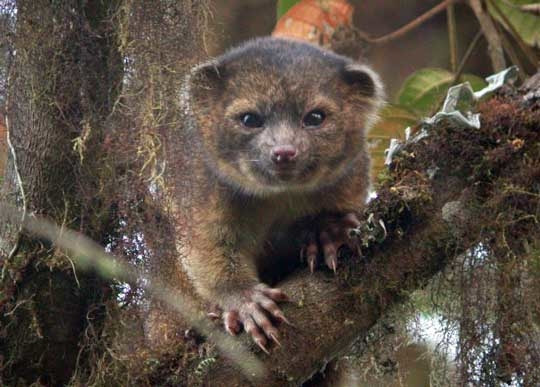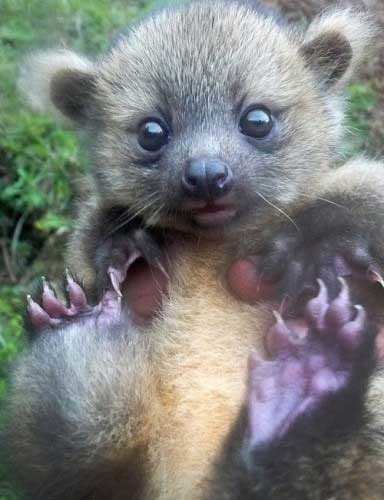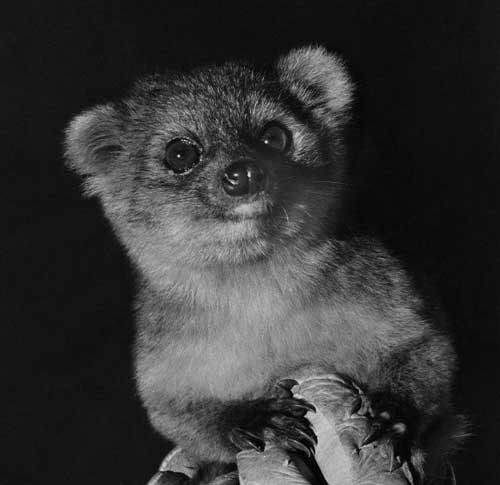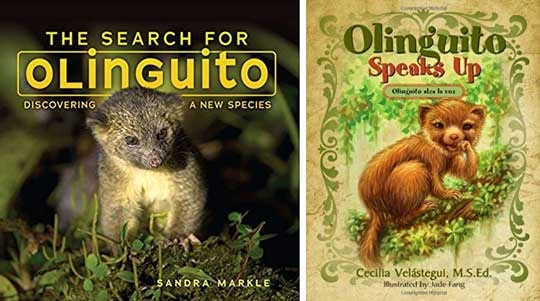|
My last two Awesome Animals were insects, and creepy ones at that. And so it's time to feature a cute and cuddly animal. Well, at least cute—wild animals are rarely cuddly. I wanted to choose an animal that many of you may not be familiar with. I was able to come up with one that had only recently been discovered, the Olinguito! So, what the heck is an Olinguito? Pronounced oh-lin-GHEE-toe. This creature is a mammal in the family Procyonidae (racoons, coatis, ringtails, kinkajous, and a few others). They live in the mountainous forests of western Colombia and Ecuador (South America). Astoundingly, the olinguito was identified only a few years ago, in 2013, making it the first carnivore mammal species identified in the Western Hemisphere in 35 years! Amazing facts about the Olinguito First, I should point out that this creature wasn't exactly discovered in 2013. It had already been observed in the wild for over 100 years. But it was properly identified in 2013. This was the result of a ten-year study of a group of mammals called olingos. A Smithsonian scientist, Kristofer Helgen, studied olingos in an attempt to understand how many different species existed. By looking at a number of types of evidence, including shape of the teeth and DNA analysis, he and his team figured out that the olinguito is not an olingo at all. Instead, it is an entirely different type of mammal, living much higher in the mountains than any of the olingos (olinguitos live from 5,000 to 9,000 feet above sea level). The olinguito is known to the locals in Colombia and Ecuador as the "kitty bear." I'm guessing this is because these creatures look like a teddy bear but are the size of a kitten. If you need further proof that the olinguito is a cute critter, check out this immature: Olinguitos are what we call omnivorous frugivores. That's just a fancy way to say they eat mainly fruit (frugivore), but they also eat a variety of other stuff (omnivorous) such as insects and nectar from flowers. Olinguitos are the smallest members of the raccoon family, averaging only about two pounds (0.9 kg). There's an interesting story behind the discovery that the olinguito is a unique species. In 1923, scientists embarked on a six-month expedition in Ecuador to collect specimens of all types of animals to better understand the wildlife there. During the trip, 1,500 mammal specimens were collected. One of them, Mammal #66573, was incorrectly labeled as a kinkajou. Below is the original expedition journal and the page detailing the collection of the first olinguito (described as a kinkajou). This specimen sat in a drawer in the American Museum of Natural History for almost 90 years before being correctly identified. In the 1970s, there was a female olinguito (named Ringerl) that spent her entire life displayed in zoos around the United States. The creature had been mislabeled as an olingo. Ringerl was frequently moved from one zoo to another because she refused to breed with the other olingos (well, duh!). Ringerl was the first and only live olinguito in captivity at that time. In about 2003, a group of mammalogists led by Kristofer Helgen began a study of olingos by looking at museum specimens, and they came across the 1923 mislabeled specimen. By examining its skull, teeth, and fur, they decided it wasn't an olingo, it was a new species. So in 2006 they set out on an expedition to find out if this new species still existed in the wild. They found some of the animals and discovered they are nocturnal, they spend most of their time alone in the treetops, and they have only one baby at a time. With the help of DNA analysis, by 2013 Helgen's team was ready to declare the olinguito a new species. It took ten years to accomplish this! Check out this video of an olinguito The photo below is of Ringerl, the first olinguito in captivity, moved from zoo to zoo in the 1970s. Interestingly, the announcement of this new species resulted in kind of a "crowdsourcing" flood of information that has helped scientists understand the creature. Soon after the announcement, Dr. Helgen received thousands of emails from naturalists, birdwatchers, and other people with sightings and observations. For example, people at the Bellavista Reserve in Ecuador emailed him that they had figured out a way to track individual olinguitos and monitor their feeding and mating habits. At a reserve in Colombia, people provided the documentation of a baby olinguito and new details about how the animals breed and nest. As a result, we now know much more about this amazing creature. The olinguito story seems to appeal to everyone, including children. There have been several olinguito kids' books published in recent years. So, the Olinguito deserves a place in the B.A.H.O.F. (Bully Animal Hall of Fame). FUN FACT: The word bully was first used in the 1530s. It was from the Dutch word boele, which means lover. The word became a popular adjective after the US president Teddy Roosevelt used it frequently to describe something's awesomeness. He used the term "bully pulpit" to describe his powerful pulpit from which to speak to the country. So, bully is another way to say awesome! Photo Credits:
Olinguito #1 - Mark Gurney, Smithsonian Insider Baby Olinguito - Juan Rendon - Scientific American Ecuador Expedition Journal - D.Finnin - American Museum of Natural History Ringerl, the misidentified Olinguito - I. Popglayen-Neuwall - Smithsonian Institute
0 Comments
Leave a Reply. |
Stan's Cogitations
Everyone needs a creative outlet. That's why I write. Archives
July 2024
|






 RSS Feed
RSS Feed